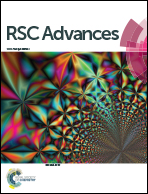A palladium complex confined in a thiadiazole-functionalized porous conjugated polymer for the Suzuki–Miyaura coupling reaction
Abstract
Porous organic polymers (POPs) with well-distributed and tunable functional groups acting as ligands for specific reactions are promising supports for confining useful novel metals such as Pd, Au, and Pd. Herein, a thiadiazole-containing POP has been successfully synthesized and used for immobilizing Pd species. Pd immobilized inside the micropores (2.3 nm) of the POP material is easily prepared owing to a large amount of the strong anchoring group, thiadiazole, which is intrinsically distributed in the as-prepared POP. The rigid thiadiazole-containing polymer can stabilize the central metal rather than poisoning it. The as-prepared catalyst shows excellent catalytic activity in Suzuki–Miyaura coupling reactions under mild reaction conditions and low catalyst loading. Importantly, the intrinsically distributed thiadiazole ligands can stabilize the Pd moiety, preventing aggregation and leaching, and afford excellent catalytic lifetimes. Consequently, the catalyst can be reused 10 times without a significant loss of its catalytic activity.



 Please wait while we load your content...
Please wait while we load your content...